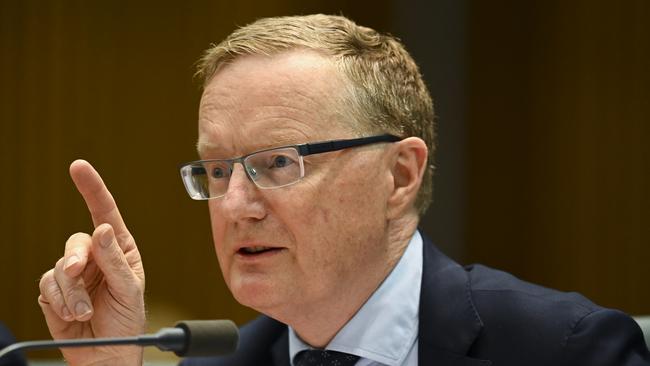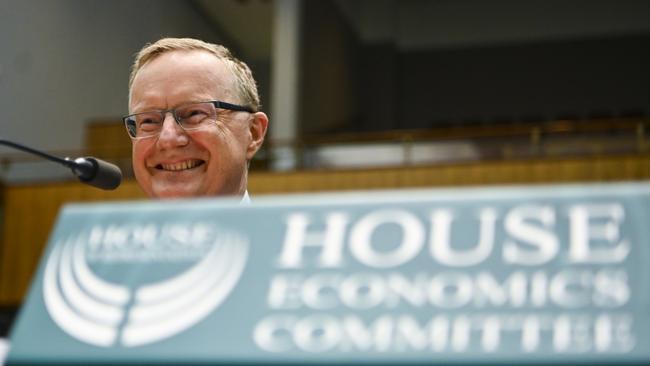RBA chief Philip Lowe flags ‘extreme’ policy option, urges lifting public sector wage caps
RBA warns of “extreme unconventional” policy if global banks’ rates go to zero, as Deutsche predicts three more cuts this year.

The Reserve Bank of Australia could launch “extreme unconventional” monetary policy to combat stalling economic growth if global central banks cut interest rates close to zero, warns RBA governor Philip Lowe.
Dr Lowe’s outlining of a scenario where the RBA would embark on a quantitative easing-style program, under which the central bank would purchase government bonds, came as Deutsche Bank economist Phil O’Donoghoe warned the official cash rate would by slashed to 0.25 per cent by the end of the year.
The RBA has made two cuts to the cash rate this year, which has pushed interest rates to a record low of 1 per cent.
But the prospect of negative official interest rates in Australia has ballooned following a shock decision by the Reserve Bank of New Zealand this week to slash its rate by 50 basis points to 1 per cent.
Financial markets expect the RBA to reduce the cash rate to 0.5 per cent by early next year, and Dr Lowe warned he was “prepared” to cut rates further from its current record low level of 1 per cent if the economy continued to sour.
New Zealand’s first 0.5-percentage-point “double whammy” rate cut since the Christchurch earthquake in 2011 came after a rocky week for markets following US President Donald Trump’s designation of China as a “currency manipulator”, as Beijing depreciated its currency as payback for another wave of US tariffs due to begin next month. The US Federal Reserve trimmed its official rate last month to a range of 2-2.25 per cent.
Dr Lowe said unconventional monetary policy, which could involve quantitative easing, or the printing of money through a government program of purchasing its own bonds, which would help force investors to plunge funds into more productive assets, was “unlikely, but it is possible”.
“Given the world we’re in it is prudent to look a these things,” Dr Lowe told the House of Representatives economics committee.
“There are scenarios where we might decides that this is warranted. We’re thinking about what we might do,” he said.
“If globally all central banks go to zero, then we’d have to consider that as well. At the moment you’re seeing every major central bank in the world expected to cut interest rates.”
Dr Lowe said the RBA would consider unconventional monetary policy if economic growth fell short of expectations, unemployment rose, and inflation remained weak.
“Extreme unconventional policy measures would need to be on the table,” Dr Lowe said.
“We would need to look at all monetary options, fiscal options and structural options,” he said.
“We wouldn’t do it at the current rate. We’d need to be very close to zero to do that. We’ve got scope to lower interest rates at least a couple times more,” he said.
The comments came as Deutsche Bank lowered its forecasts for the RBA cash rate to 0.25 per cent.
“The recent escalation of trade tensions has materially increased the probabilities of a global recession,” Deutsche’s O’Donoghoe said.
“We think delivering 75 bps of easing pre-emptively circumvents the risk of having to deliver 100 bps of easing and suffer the negative externalities associated with a defunct overnight cash rate,” he said.
“Better, in our view, to pursue as much conventional easing as possible, as quickly as possible, to fend off those scenarios. It can always be reversed.”
Trade, wages warnings
Earlier Dr Lowe told politicians had “a lot riding” on the dispute between China and the US “being resolved soon” and called on the government to scrap public sector wage caps to help lift sluggish salaries as part of a broader program to stimulate the economy.
In testimony to the parliamentary committee, Dr Lowe warned employment growth was likely to slow and again said the central bank was prepared to cut official interest rates below 1 per cent.
Despite a recent high-profile press conference at which the central bank governor appeared with Treasurer Josh Frydenberg to endorse the government’s plans, after making repeated calls for Canberra to fund major works and drive structural economic reform, Dr Lowe today reiterated his message and called for the government to borrow at record-low rates to fund infrastructure programs and to embark on productivity-enhancing reforms.
He also warned the government that if it did not launch a program of structural reforms to boost the current slowing rate of productivity “it will become a serious issue and as a society we will have to make some difficult adjustments” to the structure of Australia’s tax and transfer system.
Dr Lowe said employment growth was likely to slow and the jobless rate was unlikely to decline to 5 per cent -- down from its current level of 5.2 per cent -- until 2021.
The RBA this week downgraded its economic growth forecasts for the second time this year.
“This means that the upward pressure on wages growth over the next couple of years is likely to be only quite modest, and less than we were earlier expecting,” Dr Lowe said.
“Caps on wages growth in public sectors right across the country are another factor contributing to the subdued wage outcomes. At the aggregate level, my view is that a further pick-up in wages growth is both affordable and desirable,” he said.
Later, when questioned about the issue, Dr Lowe said: “I would like to see stronger wages growth in the country.
He noted he has tried to increase expectations for higher wages by talking up the need for bigger salaries and also keeping interest rates lower “for a long period of time”.
“Most public sectors have wage caps,” he said. “I understand why state governments are doing that because it’s important that we have budget discipline.
“On the other hand, the wage caps in the public sector are cementing low wage norms across the country. The norm is 2 to 2.5 per cent and that is partly because of the decisions taken by state governments,” Dr Lowe said.

More rate cuts?
Earlier, Dr Lowe said Australia’s economy had reached a “gentle turning point” after interest rates were cut in June and July, but further reductions were possible should the recovery falter.
He said the RBA was prepared to cut interest rates below 1 per cent -- after reducing the official cash rate twice this year from 1.5 per cent -- to help support the economy.
“The board is prepared to ease monetary policy further if there is additional accumulation of evidence that this is needed to achieve our goals of full employment and inflation consistent with the target. Time will tell,” he said.
The remarks suggest the RBA will wait a while longer before moving to push official interest rates down further from the current record low of 1.0 per cent but that lower rates “will remain on the table.”
Dr Lowe’s remarks were reinforced by the RBA’s quarterly Statement on Monetary Policy, released at 11.30am (AEST), which tipped wages and inflation to stay lower for longer.
The central bank said economic risks were more to the downside in the near term, but that cuts in the cash rate and the federal government’s tax offsets should help stimulate household consumption over the medium term.
The statement confirmed the RBA’s revised forecast on GDP for 2019, from 2.75 per cent to 2.5 per cent, as well as a more subdued outlook on inflation through 2020.
Meanwhile, as the ratcheting up of tariffs between the US and China continues to rattle global markets, Dr Lowe said the trade and technology spat was directly pushing global central banks to cut interest rates.
“These disputes pose a significant risk to the global economy,” Dr Lowe told politicians. “Not only are they disrupting trade flows, but they are also generating considerable uncertainty for many businesses around the world,” he said.
“Worryingly, this uncertainty is leading to investment plans being postponed or reconsidered. It is also now generating volatility in financial markets and has increased the prospects of monetary easing in many countries. This means that we have a lot riding on these disputes being resolved.”
Dr Lowe said there were “downsides” to the government relying on the RBA reducing interest rates to stimulate the economy, and slapped down concerns of an infrastructure bottleneck.
“Spending on infrastructure not only adds to demand in the economy but, done properly, it can boost the economy’s productivity,” Dr Lowe said.
“At the moment, there are some capacity constraints in parts of the infrastructure sector, but these should not prevent us from looking for further opportunities to boost the economy’s productive capacity and support domestic demand,” he said.
Dr Lowe said financing options were the lowest on record. “There is no shortage of finance to do this, with interest rates the lowest they have ever been. This week, all governments in Australia can borrow for 10 years at less than 2 per cent.”
With recent warnings from former Treasury boss and outgoing head of Prime Minister and Cabinet Martin Parkinson that Australia needed to double its productivity rate to maintain its tax and transfer system, Dr Lowe said the country would “do better if Australia is viewed as a great place to expand, invest, innovate and employ people”.
“A program of structural reform would help move us in this direction. It would also help boost productivity growth, which over recent times has slowed noticeably. If this slowing is maintained, it will become a serious issue and as a society we will have to make some difficult adjustments,” Dr Lowe said.
With Dow Jones




To join the conversation, please log in. Don't have an account? Register
Join the conversation, you are commenting as Logout